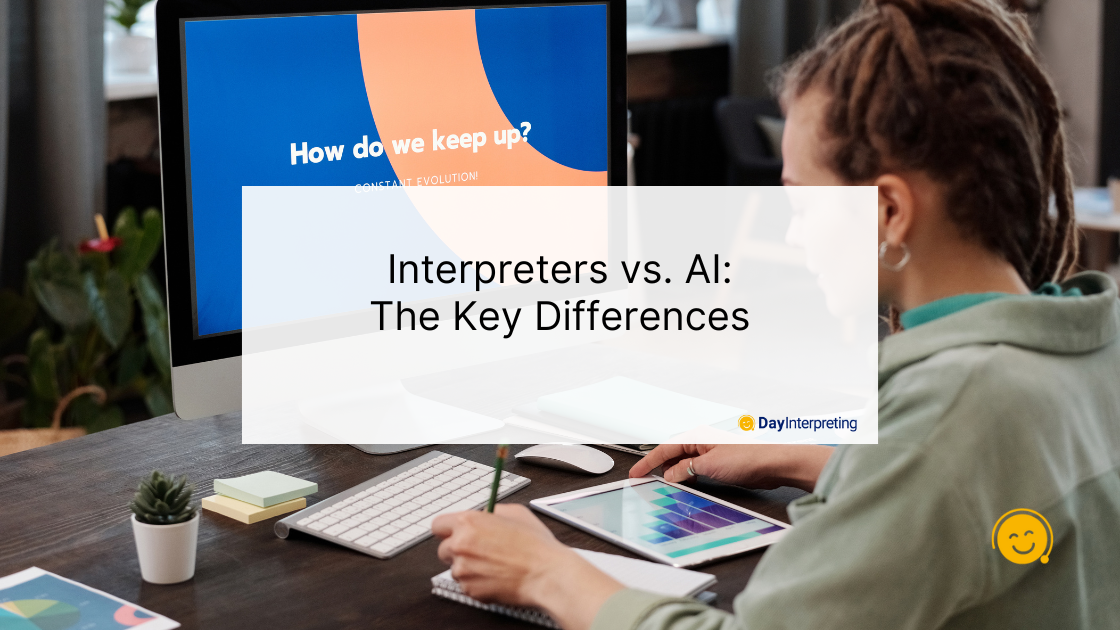Communication across language barriers is more critical than ever. The demand for effective language interpretation services has grown exponentially, leading to the emergence of artificial intelligence (AI) as a potential solution. While AI has made remarkable progress in various fields, including natural language processing, it is essential to understand the fundamental differences between human interpreters and AI in the context of language interpretation. This article will explore the differences in interpreters vs. AI and shed light on why choosing human professionals for interpretation services is still a paramount choice, ensuring cultural competence and accurate interpretation of cultural nuances that AI cannot replicate.
Understanding AI Interpretation
Artificial Intelligence (AI) interpretation refers to the use of computer programs, algorithms, and machine learning techniques to convert spoken or written language from one language to another. These AI systems use vast databases of language data, neural networks, and statistical models to make sense of language. The most common AI interpretation tools include translation apps, chatbots, and virtual assistants like Google Translate and Siri. These systems have gained popularity due to their convenience and cost-effectiveness.
The Strengths of AI Interpretation
- Speed and Efficiency: AI interpretation is incredibly fast, capable of processing vast amounts of text or speech within seconds. This can be invaluable in scenarios where quick, simple translations are needed.
- Cost-Effective: AI interpretation can be cost-effective and accessible to a broader audience, making it an attractive choice for businesses and individuals with limited budgets.
- Consistency: AI systems provide consistent translations, reducing the risk of human errors and variations.
The Limitations of AI Interpretation
- Lack of Cultural Competence: AI systems lack the ability to understand cultural nuances, context, and regional variations in language. This often leads to translations that are technically accurate but culturally inappropriate or insensitive.
- Inability to Interpret Context: AI interpreters cannot always grasp the broader context of a conversation, making them ill-equipped to provide meaningful interpretations in more complex or nuanced discussions.
- Limited Understanding of Idioms and Slang: AI systems struggle to comprehend idiomatic expressions and slang, which are prevalent in everyday language use.
- No Emotional Intelligence: AI interpreters cannot detect or respond to emotions, tone, or non-verbal cues that play a crucial role in human communication.
The Strengths of Human Interpreters
- Cultural Competence: Human interpreters possess a deep understanding of the cultures and societies they work with, allowing them to navigate cultural nuances effectively. This cultural competence is invaluable for international diplomacy, business negotiations, and healthcare settings.
- Contextual Understanding: Human interpreters can interpret language within the broader context of a conversation, facilitating more meaningful and accurate translations in complex discussions.
- Adaptability: Human interpreters can adapt to different situations, including formal meetings, casual conversations, and emotional contexts, ensuring a more natural and appropriate interpretation.
- Emotional Intelligence: Human interpreters can gauge the emotions and intentions of the speakers, allowing them to respond effectively and empathetically.
The Importance of Cultural Competence
One of the most significant distinctions between human interpreters and AI is the issue of cultural competence. Cultural competence is the ability to understand and respect cultural differences and nuances that can greatly impact communication. In an increasingly globalized world, bridging cultural gaps is paramount, as misunderstandings can lead to unintended consequences in various domains, including international diplomacy, business transactions, and healthcare.
Human interpreters are uniquely equipped to navigate these cultural complexities. They have often spent years studying and immersing themselves in the languages and cultures they work with, enabling them to interpret not just words but also the intentions, beliefs, and values that underlie them. This level of insight is beyond the reach of AI.
The Future of Interpretation
While AI interpretation tools are becoming more sophisticated and convenient, they still have a long way to go before they can rival the skills and cultural competence of human interpreters. As AI develops, it will undoubtedly play an essential role in providing quick, simple translations for everyday use. However, when it comes to complex, culturally sensitive, or emotionally charged interactions, human interpreters remain the preferred choice.
Final Thoughts on Interpreters vs. AI
In the ongoing debate of interpreters vs. AI, it is evident that both have their unique strengths and limitations. AI interpretation is efficient, cost-effective, and suitable for simple translations. However, when it comes to nuanced communication, cultural competence, and the accurate interpretation of cultural nuances, human interpreters are unrivaled. As the world continues to globalize and cultural competence becomes increasingly vital, choosing human professionals ensures that communication transcends linguistic barriers and fosters understanding and respect across cultures. It is this human touch, empathy, and cultural competence that make human interpreters indispensable, even in the age of artificial intelligence.





0 Comments